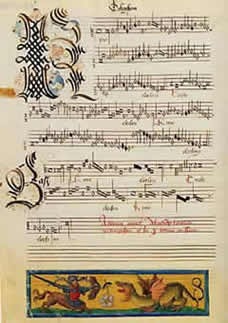Polyphony Is Not a Sin
by Gary D. Penkala
 The local classical radio station, WQED, had a promotional bumper sticker that I thought was very clever.
It read:
The local classical radio station, WQED, had a promotional bumper sticker that I thought was very clever.
It read:
POLYPHONY IS NOT A SIN
For many centuries, Church documents, in discussing liturgical music, have linked Gregorian chant with its more recent offspring, "sacred polyphony."
The nobility and honored position of each within the liturgy of the Roman Rite is undisputed.
Polyphony, in the strict music theory sense, is a composition with two or more independent melodic lines that proceed horizontally to produce an effective implied or literal harmony as well.
The word means "many sounds."
A round or canon is a simple example of polyphony.
A six-voice, double fugue is a much more complex example, with extensive rules and "rubrics."
The ubiquitous linking of Gregorian chant and sacred polyphony is quite natural — polyphony developed historically from chant.
Chant is a monophonic (meaning "one sound") texture: unison, unaccompanied – a single melody line.
Music historians note the eventual addition of another part, which at first was simply the same melody sung five pitches higher; this was called parallel organum.
It involved the same melody at two pitch levels, both moving identically, like two snakes on the sand.
When it became apparent that intersting resting points, or "cadences," could be sprinkled throughout the piece by altering the second melody occasionally, the rudiments of harmony developed.
The concept of the beauty of various pitches sounding together blossomed, and polyphony ("many sounds") was born.
This was practiced, honed and improved through the Medieval and Renaissance periods.
Were it not for the absolute glories of the music, one might even use the word "exploitive" when describing the multi-choral works of the Renaissance, like the motets of Gabrieli and Tallis that were written for as many as 40 different voice parts!
When the Church mentions sacred polyphony she most often means the religious works of the masters of the Renaissance like Palestrina, Victoria, Tallis, and others, although the term can certainly be broadened to include such "non-polyphonic" works as Mozart's Ave verum and "non-Renaissance" pieces like Duruflé's Ubi caritas.
CanticaNOVA Publications is commited to the promotion of both Gregorian chant [see our Booklets of Chant] and sacred polyphony.
We publish a number of motets in our Treasury of Sacred Music series that fall under the second category.
Check out some of these for your choir!
- Alma redemptoris mater (G.P. da Palestrina)
This traditional Marian antiphon for Advent and Christmas is set by one of the finest Renaissance composers, Giovanni Pierluigi da Palestrina, often called "The Savior of Church Music."
The voice ranges and level of difficulty are well within the scope of most SATB choirs.
This motet is a testament to Palestrina's compositional skill and will make any choir sounds its best.
Our edition is compiled by Prof. Andrea Angelini, the Director of "Alessandro Grandi" Choir of Rimini Cathedral and the Artistic Director of the International Festival "Voci dall'America e Suoni dell'Organo" which takes place each spring in Rimini, Italy.
He brings to his editions the precision of a scholar and the pragmatism of a church choir director.
- Ave Maria (Jacob Arcadelt)
This setting of the "Ave Maria" by Jacob Arcadelt has, over the centuries, become almost as familiar as the text itself.
It is from motets such as these that the traditional rules of music theory developed.
One can easily hear in the beauty of the voice leading and harmonic structure why standard "Classical Harmony" has endured and is still being taught today to every beginning music theory student.
Our edition is compiled by Prof. Andrea Angelini.
- Ave Maria (Tomás Luis de Victoria)
Tomàs Luis de Victoria was a Spanish composer-priest of the sixteenth century.
His meticulous choral writing embodied the spirit and myticism of the great Spanish saints, Teresa of Avila and John the Cross.
He spent over twenty years in Rome, learning the sublime Renaissance style from his teacher Palestrina.
Invigorated by the climate of the Catholic Counter-reformation, he composed only sacred music, before returning to Madrid to spend his last years in the simple life-style of a discalced Carmelite.
This setting of the Ave Maria, the salutation of the Angel Gabriel to Mary, seems to have been published only after the composer's death, even though now it is one of his most beloved works.
It borrows the incipit, or "introduction," from the Gregorian chant setting of the same text.
Prof. Angelini, of Rimini, Italy, has edited Victoria's manuscript, using changing time signatures to capture the flowing rhythms of the original, and has added suggestions for tempi and dynamics.
- Caligaverunt oculi mei (Tomás Luis de Victoria)
Tomàs Luis da Victoria was one of the most gifted and influential composers of the Catholic Counter-reformation.
Caligaverunt oculi mei is the text for the Responsory after the last Lesson of Good Friday Matins.
It was part of the traditional Tenebræ service sung on the evening before Good Friday, and expresses profound tenderness of emotion at the words of the innocent Lamb: "Behold, see if there be any sorrow like unto my sorrow."
Prof. Angelini, of Rimini, Italy, has edited Victoria's manuscript to enhance the emotional yet restrained nature of the music, and has added suggestions for tempi and dynamics.
|


 The local classical radio station, WQED, had a promotional bumper sticker that I thought was very clever.
It read:
The local classical radio station, WQED, had a promotional bumper sticker that I thought was very clever.
It read: